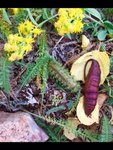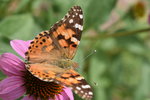



“Can I still plant this late?” Is a common query I get in the fall at the Silver City Farmers Market. We are all eager to plant in the spring, we are itching to be outside in the warm sun, tired of the cold nights and imagining our gardens full of blooms and pollinators.
The nurseries are full of colorful perennials and shrubs to further entice us. So, we go home at the end of May with our future garden in tow and we become slaves to their needs, watering every day to help them establish during the desiccating winds and relentless sun and heat of June. We even build little cages to protect them from starving deer and screens to protect them from sunburn. So, having acknowledged the inevitable spring gardening urge, I will tell you now that fall through early winter is the best time to plant natives in the Southwest. The only drawback is that nurseries are low on stock.
The cooler weather of fall creates ideal conditions for establishing new plants. Fall days are still warm, soil is still moist from recent monsoons and nights are much cooler. This creates the dew we wake up to in October and November. Here are the main reasons for fall planting:
Saves water – With cooler nights and lower daytime temperatures, and lack of hot winds, plants do not need as much water. The soil retains more moisture in the fall and winter and there is dew during fall mornings.
Root growth – In the process of going dormant, plants cease expending energy on leaf and flower. Much of the root growth occurs in fall and winter. Plant now because conditions are more conducive, giving plants a head start for the next year.
Healthier better-established plants – A well-rooted plant will support more vigorous top growth in the following season.
Exceptions to fall and winter planting are cold-sensitive species like certain cacti and tender sages, which are best saved for spring and summer planting.
This is also the time of year that folks feel the need to tidy up their garden landscape. I am not a big fan of artificial-looking manicured gardens. Many people are not aware of the plight of our pollinators and how their gardening efforts can affect them. So, as you get your weed whacker working and your best garden gloves out, remember to be mindful of pollinator habitat. It is a good time to weed out all the undesirable plants that are non-native, invasive or tend to spread with irritating seeds (even natives) that cling to your clothing or puncture your wheel barrow tires or poison your livestock.
Here are a few do’s and don’ts of fall gardening:
Many people want to plant natives because they are designing gardens with permaculture principles. Bill Mollison, one of the founders of permaculture, best describes it as “The conscious design and maintenance of agriculturally productive systems which have the diversity, stability, and resilience of natural ecosystems. It is the harmonious integration of the landscape with people providing their food, energy, shelter and other material and non-material needs in a sustainable way.”
Native plants are a natural choice when employing permaculture concepts. They have had a millennia to adapt to the specific conditions of their ecosystem, whether it be the ability to survive on little water or forming beneficial relationships with mycorrhizae and other organisms. Plant with stacking functions in mind, like buffaloberry and serviceberry for their ability to fix nitrogen and their edible berries for both people and wildlife. Consider planting native trees like net-leaf hackberry for its ability to grow in alkaline soil, it’s longevity, berries, drought tolerance and the shade it provides.
Get out and observe what the birds and pollinators are doing in the fall. It is a great time to watch the butterflies feeding on our native chamisa (rabbitbrush), bees on the native goldenrod, and flocks of birds in the grasses. Take note of late blooming flowers that the hummingbirds are still visiting; Aniscanthus, Salvias, Agastaches, like sunset hyssop, and hummingbird trumpets. Enjoy New Mexico’s fall color; three-leaf sumac and other native sumacs turn shades of orange and red; New Mexico olive, western soapberry and velvet ash turn brilliant yellow in the fall. See if you can incorporate these native plants in your home landscape.
Tricia Hurley is co-owner with her husband, Mark Cantrell, of Lone Mountain Natives in Silver City. They have been growing, selling and learning about native plants for the past 13 years. They have a home nursery and sell at the local farmers market in downtown Silver City. Contact them at lonemtn@q.com or visit their website at www.lonemtnnatives.com.